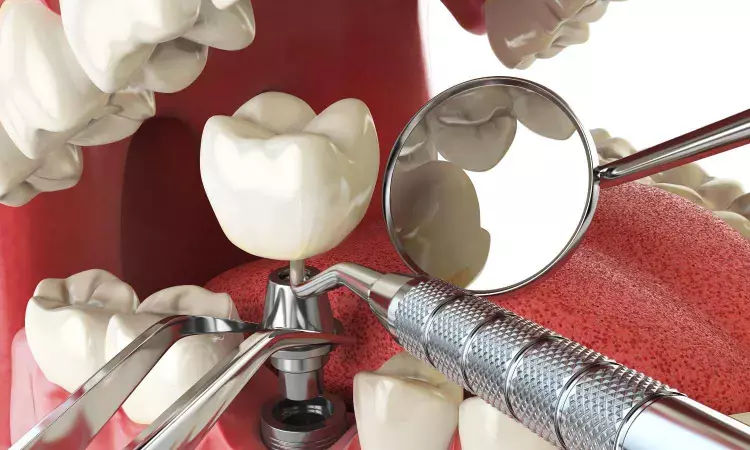- Home
- Medical news & Guidelines
- Anesthesiology
- Cardiology and CTVS
- Critical Care
- Dentistry
- Dermatology
- Diabetes and Endocrinology
- ENT
- Gastroenterology
- Medicine
- Nephrology
- Neurology
- Obstretics-Gynaecology
- Oncology
- Ophthalmology
- Orthopaedics
- Pediatrics-Neonatology
- Psychiatry
- Pulmonology
- Radiology
- Surgery
- Urology
- Laboratory Medicine
- Diet
- Nursing
- Paramedical
- Physiotherapy
- Health news
- Fact Check
- Bone Health Fact Check
- Brain Health Fact Check
- Cancer Related Fact Check
- Child Care Fact Check
- Dental and oral health fact check
- Diabetes and metabolic health fact check
- Diet and Nutrition Fact Check
- Eye and ENT Care Fact Check
- Fitness fact check
- Gut health fact check
- Heart health fact check
- Kidney health fact check
- Medical education fact check
- Men's health fact check
- Respiratory fact check
- Skin and hair care fact check
- Vaccine and Immunization fact check
- Women's health fact check
- AYUSH
- State News
- Andaman and Nicobar Islands
- Andhra Pradesh
- Arunachal Pradesh
- Assam
- Bihar
- Chandigarh
- Chattisgarh
- Dadra and Nagar Haveli
- Daman and Diu
- Delhi
- Goa
- Gujarat
- Haryana
- Himachal Pradesh
- Jammu & Kashmir
- Jharkhand
- Karnataka
- Kerala
- Ladakh
- Lakshadweep
- Madhya Pradesh
- Maharashtra
- Manipur
- Meghalaya
- Mizoram
- Nagaland
- Odisha
- Puducherry
- Punjab
- Rajasthan
- Sikkim
- Tamil Nadu
- Telangana
- Tripura
- Uttar Pradesh
- Uttrakhand
- West Bengal
- Medical Education
- Industry
Dental implants still functional after forty years, reports research

Dental implants used to replace single teeth continue to function well after several decades, according to a study from the University of Gothenburg, Sweden. After nearly forty years, all examined implants were still in place and fully functional.
The study is the longest follow-up study of single dental implants in the world and is based on a follow-up of a small group of patients who received single implants to replace missing teeth between 1982 and 1985.
The implants are a result of research conducted by Professor Per-Ingvar Brånemark at the University of Gothenburg. His discovery of how bone integrates with titanium implants has enabled millions of patients to replace lost teeth with a reliable and long-lasting solution.
Stable implants
Of the 16 patients who received implants during the study period, 13 participated in the follow-up, conducted at the Brånemark Clinic, Public Dental Service Västra Götaland. These 13 patients had a total of 18 implants.
"It is impressive that the single implants function so well after such a long time. Even though the study included a small number of patients, the results show that the implants remain in place and that the bone loss around them is virtually unchanged after forty years. This confirms that the foundation Brånemark established still holds," says Sargon Barkarmo, prosthodontist and senior lecturer at the University of Gothenburg.
A dental implant is an artificial tooth root made of titanium that is surgically placed into the jawbone, where it integrates and becomes stable. A crown is then attached to the implant, providing both functionality and aesthetics.
The crowns placed on the implants had a shorter lifespan than the implants themselves. At the forty-year follow-up, only about 60 percent of the original crowns remained, with many having been replaced one or more times.
"The study shows that the crowns were mostly replaced for aesthetic reasons rather than technical failures. In the future, implant treatments could be further improved with the development of new crown materials," says Jan Kowar, prosthodontist and senior lecturer at the University of Gothenburg, and co-author of the study.
Implants and healing
The researchers point out that older implant systems, which have been shown to be highly effective, are unfortunately no longer available on the market. This is due to the continuous introduction of new systems that quickly replace older ones, despite their proven long-term success.
The study concludes that implants placed using well-planned surgical techniques and given sufficient healing time have an excellent long-term prognosis. Sargon Barkarmo again:
"Today, methods that accelerate treatment and healing are commonly used. These approaches also need long-term follow-ups and careful evaluation to ensure equally good results over time," he says.
Reference:
Sargon Barkarmo, Jan Kowar, Outcome of Single Dental Implants Over 38–40 Years: A Long-Term Follow-Up Study, Clinical Implant Dentistry and Related Research, https://doi.org/10.1111/cid.13443
Dr Kamal Kant Kohli-MBBS, DTCD- a chest specialist with more than 30 years of practice and a flair for writing clinical articles, Dr Kamal Kant Kohli joined Medical Dialogues as a Chief Editor of Medical News. Besides writing articles, as an editor, he proofreads and verifies all the medical content published on Medical Dialogues including those coming from journals, studies,medical conferences,guidelines etc. Email: drkohli@medicaldialogues.in. Contact no. 011-43720751


